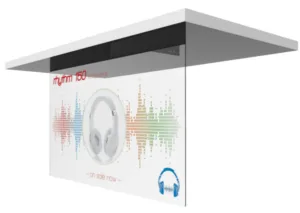Earlier this year, Planar showed a 55″ transparent OLED display at ISE (Planar Talks 100% UltraHD), although little information was available (it was also shown by others including NEC and Eyevis as well as Samsung’s Display Division – Man. Ed). The company has now announced that there will be four variants, and has released specifications for all of them.
Although specifications are identical, the usage for each product is different. The LO55 is the standard display. 32-point IR touch can be added (LO55-T), or the unit can be supplied with a straight-mount design for integration into custom fixtures (LO55-S). Alternatively, both of these features can be combined (LO55-S-T).
Each display can be mounted in portrait or landscape orientation. They are fanless, last for 30,000 hours and are RoHS-compliant. Planar has built them using an AMOLED panel from Samsung Display. Transmissivity is 45%.
Resolution is 1920 x 1080. The displays have 150 cd/m² of full screen white brightness, or 500 cd/m² of peak white brightness; brightness uniformity is 20%. Viewing angles are 178°.
As an OLED screen, the LO55 products show 10-bit colour (100% NTSC gamut coverage), with a sub-1ms response time and contrast ratio said to exceed 100,000:1. Refresh rate is 120Hz, and the display is protected by Gorilla Glass. DisplayPort, HDMI (x4), RS232, RJ45 and USB-B inputs are featured.
Planar has not announced a release date or price for its OLED screens yet.
Analyst Comment
The development of these displays, with such high transparency, is a great technical achievement, given the problems with making large OLEDs, although the transparency feature really exploits the method of making OLEDs without filters (which is what Samsung is developing, unlike LG which does use filters). However, we have heard from others that the warranty terms for these transparent displays are very stringent with, for example, tight limits on the level of ambient light that the displays can be exposed to.
Of course, if you have challenges in making high volumes at low prices (as Samsung has for TVs), it makes a lot of sense to develop the technology by working on lower volume markets where a unique feature, such as the transparency, is a unique feature. (BR)

